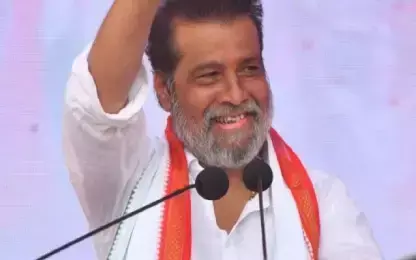Live
- Sudanese army recaptures capital of Sinnar State in central Sudan
- Kishkindha Kaandam Review: Some movies prove not to compromise in having a good cinematic experience and this is one of them
- Son-rise: Hemant Soren grows taller as tribal leader, makes father proud
- ISL 2024-25: 10-man NorthEast United FC hold on to take three points vs Punjab FC
- BGT 2024-25: Jaiswal’s application, commitment to form a partnership was so impressive, says Gilchrist
- BGT 2024-25: Personally, I am very happy with my performance, says Harshit Rana
- Pakistan's Lahore remains world's most polluted city despite light drizzle
- Asha Nautiyal retains Kedarnath for BJP, to be back as MLA after 12 years
- India leads world in science, innovation research: Minister
- Flash flood in Indonesia's South Tapanuli claims two lives
Just In
Deputy CM Rajanarasimha Highlights Development Disparities in Telangana Region


Deputy Chief Minister D Rajanarasimha reports to Congress Core Group, detailing the diversion of Telangana’s natural resources to other regions of Andhra Pradesh. He highlights inequalities in power generation, water distribution, and irrigation, underscoring the ongoing struggle for development in Telangana.
Damodara explains lop-sidedness in development Hyderabad: The Deputy Chief Minister D Rajanarasimha in his report to the Congress Core Group on July 12 explained how the Telangana region which was endowed with abundant natural resources like coal and water which are essential for the development of power sector have been diverted for the development of other regions of Andhra Pradesh.
Rajanarasimha said of the total installed capacity of 16,386 MW in the state, the installed capacity in Seemandhra region was 10,489 MW (64%) and in Telangana it was just 5,897 MW (36%). On the other hand the demand for power in T region is 56% while it is 44% in Seemandhra. There has been discrimination even in regard to setting up projects region wise. While the Installed capacity in Seemandhra is 15,862 MW which is 70%, in the backward T region it is just 6,660MW (30%).
He explained that the actual base load power generating capacity in Telangana is only 4,000 MW whereas the power demand in the region is around 6,000 to 6,500 MW. To buy the deficit power from outside it would cost the ex-chequer Rs 10,000 crore per annum. The state, Rajanarasimha said has been starving for water though the two major rivers Krishna and Godavari traverse through Telangana.
The catchment area of T region in Krishna is 68.50% (51,628 sq kms) and in Godavari it is around 79% (61,780 sq kms.) The Bachawat Award had allocated 900 TMC of water from Godavari and 298 TMC from Krishna. While there would be no change in the allocation even after bifurcation, an order from the Brijesh Kumar Tribunal in regard to surplus water from river Krishna is awaited. In terms of major irrigation there has been an increase of 8.5 lakh acres between 1956 and 2009 while there has been a corresponding decrease under minor irrigation during the same period. Even the number of irrigation tanks had come down from 80,000 in 1956 to 20,000 by 2009 while in Seemandhra region it has gone up from 20,000 to 40,000 during the corresponding period. When the Government of India took decision in favour of unification of two regions, it unilaterally promised several safeguards. The state assembly also passed two resolutions.
The first one was moved by the then Chief Minister B Gopala Reddy on November 25, 1955 and second one by Deputy Chief Minister N Sanjeeva Reddy in February 1956. According to these Gentlemen agreements, given constitutional status in 1956, matters relating to revenue, educational facilities, recruitment and retrenchment of service personnel, status of Urdu, Mulki rules, sale of agricultural lands and revenue were guaranteed. In pursuance of this the Presidential Order that came into existence in 1958 constituting regional council for T comprising 105 members of state assembly from T region. But over the years, Mulki rules were violated, regional committees were marginalized and revenue from the region was diverted and this gave birth to movement for separate Telangana in 1969.
The Supreme Court in 1972 declared Mulki rules as valid with retrospective effect. This led to Jai Andhra Movement and following it, the government brought in six point formula to provide safeguards in education and employment. Though the Government of India gave constitutional validity to six -point formula and issued Presidential Order, it was blatantly violated between 1975 and 1985, the report added.
To redress this issue, GO 610 to repatriate employees to relevant zones was issued in 1985 but was not implemented. In 2001, the TDP appointed a one man Commission with GM Girglani ,a retired IAS officer, to investigate the violations of Presidential Order. The Commission in 2004 reported that the Order was violated according to the whims and fancies of Andhra officers. With T movement picking up, the Congress party in its manifesto in 2004 took note of the issue and incorporated in the UPAs Common Minimum Programme and Presidential address. But due to delay in taking a decision, the state was now divided on regional lines, the Deputy Chief Minister said.

© 2024 Hyderabad Media House Limited/The Hans India. All rights reserved. Powered by hocalwire.com






